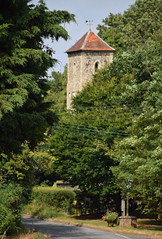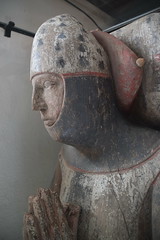| |
|
St
Andrew, Fersfield
 |
|
The
maze of lanes between Diss and Thetford hides
secretive villages. This part of south Norfolk
can seem remote even today, so it is surprising
that Fersfield holds an important place in the
history of Norfolk parish churches, as we shall
see. The church sits where the lanes come
together, its truncated, pencil-like tower a
beacon across the fields and farmlands. The
capped tower is reminiscent of Culpho and
Thornham Parva in Suffolk, and apart from its cap
probably dates from the early 14th Century. If
so, it is later than the bulk of the church
against which it sits. There were further
improvements, for money in the late 15th Century
brought a fairly imposing south aisle and porch,
and the chancel is entirely Victorian, I think.
But it all works well together, especially when
seen from the south-east.
St Andrew was the home parish for much of his
life of Francis Blomefield, author of the early
18th Century History of Norfolk.
Blomefield was one of the first of a generation
of 18th Century historians who recovered the past
from the oblivion to which the 16th Century
Anglicans and 17th Century Puritans had done so
much to consign it. From the modern point of
view, his most valuable work was a survey of the
contents of the parish churches of the county.
For some churches, this is just about the only
record we have between late medieval wills and
bequests on the one hand, and the passion for
recording medieval features that arose under the
Victorians on the other. |
Francis
Blomefield was born in 1705, and later biographies record
that he developed a fascination for visiting churches as
a child. Ordained as an Anglican minister in 1729, he
briefly became Rector of Hargham and then came to
Fersfield, where he would spend the rest of his life. He
was not always a well man, and although he visited many
of the churches himself, the bulk of his work involved
sending questionnaires to ministers of other churches.
Because of this, and because Blomefield himself did not
always understand what he was seeing or reading about,
the survey needs to be used with care. Moreover,
Blomefield did not finish it. It is easy to imagine 18th
Century antiquarians as bewhiskered old men sitting with
quill pens at high desks, but Blomefield contracted
smallpox and died at the age of 47. His work was
completed by friends, most notably Charles Parkin and
William Whittingham.
I wonder how much Blomefield would recognise his own
church if he came back to it today. The furnishings are
all modern, and the feel is of a pleasantly light space
of the late 19th and early 20th Centuries. His memorial
is in the rebuilt chancel, a fairly simple ledger stone
set, not inappropriately, beneath the kind of 17th
Century panelling which must have been familiar to him.
Less happy is the clumsy reredos, which looks as if some
of the paneling had been left over and cobbled together
with a picture of the Last Supper.
Even
today, St Andrew is not without Antiquarian
interest. Above Blomefield's memorial in the east
window are three roundels of glass, all of which
are continental I think. They depict St Andrew,
St Gregory, and the eagle of St John. They were
probably placed here by the Victorians at the
time of the rebuilding of the chancel. Curiously,
Blomefield records quite a lot of medieval glass
at Fersfield, mostly from the narrative of the
Blessed Virgin, which is now all gone.
The most famous medieval survival is Robert du
Bois, the man in the glass case. This painted
wooden effigy sits in the south aisle. Du Bois
died in 1311, and was probably responsible for
the rebuilding of the tower. He lies with his
legs uncrossed, a rather surprised buck at his
feet. Nearby is a relatively plain Norman font.
There is a strange stone effigy in an alcove up
in the chancel, obviously reset by the
Victorians. It appears to show a woman, although
it may well be a recut image of a 13th Century
Priest. But despite the modern ambience, this is
a church in which to recall the 18th Century. The
south aisle contains more Blomefield memorials,
curly ones on the walls and simple ledgers on the
floor. And, looking down on them all, the great
royal arms of Queen Anne dated 1703, two years
before Francis Blomefield was born. |
|
 |
Simon Knott, August 2018
|
|
|
